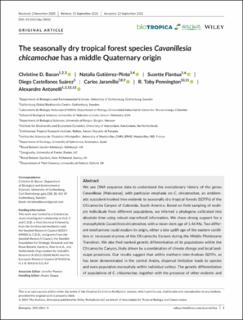The seasonally dry tropical forest species Cavanillesia chicamochae has a middle Quaternary origin
| dc.contributor.author | Bacon, Christine D. | |
| dc.contributor.author | Gutiérrez-Pinto, Natalia | |
| dc.contributor.author | Flantua, Suzette | |
| dc.contributor.author | Castellanos Suárez, Diego | |
| dc.contributor.author | Jaramillo, Carlos | |
| dc.contributor.author | Pennington, R. Toby | |
| dc.contributor.author | Antonelli, Alexandre | |
| dc.date.accessioned | 2021-12-15T14:12:57Z | |
| dc.date.available | 2021-12-15T14:12:57Z | |
| dc.date.created | 2021-11-23T14:37:59Z | |
| dc.date.issued | 2021 | |
| dc.identifier.issn | 0006-3606 | |
| dc.identifier.uri | https://hdl.handle.net/11250/2834518 | |
| dc.description.abstract | We use DNA sequence data to understand the evolutionary history of the genus Cavanillesia (Malvaceae), with particular emphasis on C. chicamochae, an emblematic succulent-trunked tree endemic to seasonally dry tropical forests (SDTFs) of the Chicamocha Canyon of Colombia, South America. Based on field sampling of multiple individuals from different populations, we inferred a phylogeny calibrated into absolute time using robust macrofossil information. We show strong support for a monophyletic Cavanillesia chicamochae, with a mean stem age of 1.46 Ma. Two different mechanisms could explain its origin, either a late uplift age of the eastern cordillera or increased dryness of the Chicamocha Canyon during the Middle Pleistocene Transition. We also find marked genetic differentiation of its populations within the Chicamocha Canyon, likely driven by a combination of climate change and local landscape processes. Our results suggest that within northern inter-Andean SDTFs, as has been demonstrated in the central Andes, dispersal limitation leads to species and even population monophyly within individual valleys. The genetic differentiation of populations of C. chicamochae, together with the presence of other endemic and threatened species in the Chicamocha Canyon, calls for urgent management to conserve the unique biodiversity in the region. | en_US |
| dc.language.iso | eng | en_US |
| dc.publisher | Wiley | en_US |
| dc.rights | Navngivelse 4.0 Internasjonal | * |
| dc.rights.uri | http://creativecommons.org/licenses/by/4.0/deed.no | * |
| dc.title | The seasonally dry tropical forest species Cavanillesia chicamochae has a middle Quaternary origin | en_US |
| dc.type | Journal article | en_US |
| dc.type | Peer reviewed | en_US |
| dc.description.version | publishedVersion | en_US |
| dc.rights.holder | Copyright 2021 The Author(s) | en_US |
| cristin.ispublished | true | |
| cristin.fulltext | original | |
| cristin.qualitycode | 1 | |
| dc.identifier.doi | 10.1111/btp.13031 | |
| dc.identifier.cristin | 1957911 | |
| dc.source.journal | Biotropica | en_US |
| dc.identifier.citation | Biotropica. 2021 | en_US |
Tilhørende fil(er)
Denne innførselen finnes i følgende samling(er)
-
Department of Biological Sciences [2235]
-
Registrations from Cristin [9791]

